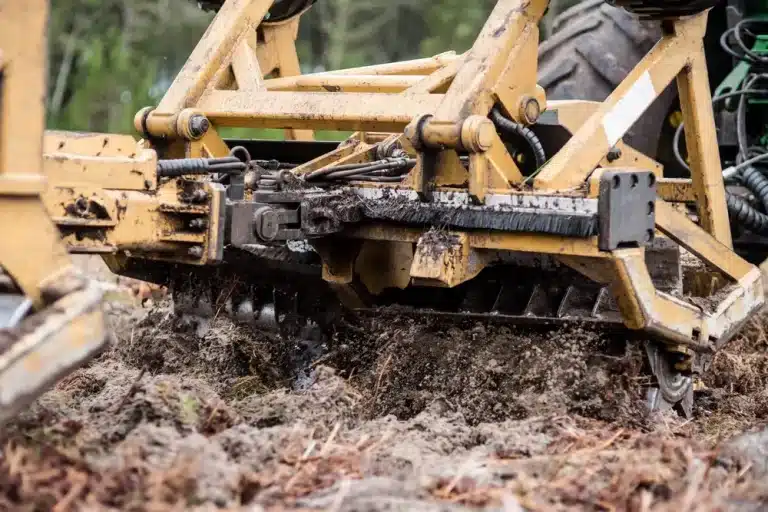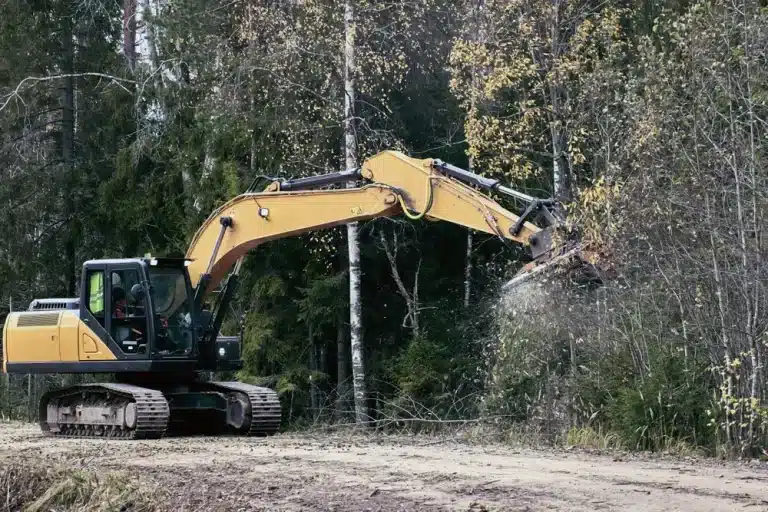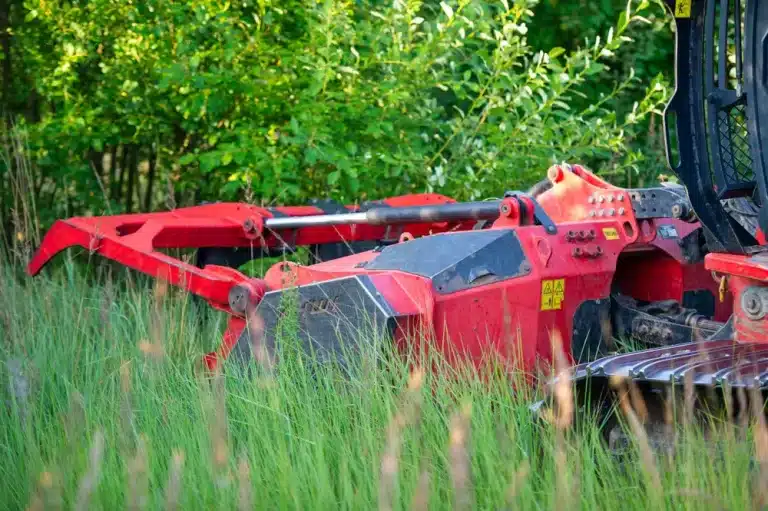In disaster zones, every hour counts: roads need to be cleared, access restored, and hazards eliminated before support teams can even begin their work.
Forestry mulchers and chippers each bring key advantages when it comes to cutting through debris, fallen trees, and overgrowth after fires, floods, or storms, as detailed in our use cases.
But the tool alone is not enough. What matters is choosing the right machine-tool setup that matches your terrain and mission.
While mulchers shred vegetation in place to clear large surfaces quickly, chippers are essential when you need clean, transportable wood chips. Both can be used together depending on the type of debris and the operational priorities.
Clearing blocked areas under pressure
Natural disasters create chaotic, unstable environments where urgency and safety must go hand in hand.
Roads, trails and access points often disappear under fallen trees, debris and tangled brush. In these conditions, machines are not just tools, they are lifelines.
The ability to clear blocked zones quickly, without adding risk to operators or surrounding teams, is critical.
A mulcher or chipper that performs well under pressure can make the difference between a delayed intervention and a rapid, controlled response, especially when properly selected, as explained in our guide on how to choose the right mulcher for your machine.
Stability, balance and control are just as important as raw power when the terrain shifts, visibility drops and time is limited.
Dealing with mixed debris and terrain
No disaster leaves behind clean nor safe work zones.
A flooded plain might contain layers of silt, downed branches and submerged hazards and a burned forest may combine thick undergrowth, scorched stumps and twisted fencing.
A good forestry mulcher cuts through organic material fast, transforming obstacles into mulch without the need for hauling while in areas with larger tree limbs or when operating along cleared edges, a chipper becomes a valuable complement, turning bulky wood into compact loads.
The goal is not just to remove debris, but to do so in a way that maintains pace, safety and operational efficiency across changing conditions.
Speed without exposure
In emergency response, every delay has consequences, every second matters.
All access must be restored before firefighters, medics or utility teams can act. Using a mulcher or chipper allows a single operator to do the work of a full crew with fewer passes and less direct exposure. This is especially important in smoke-filled areas, unstable slopes or zones with electrical hazards. A properly matched setup, machine plus head, minimizes time spent in the danger zone. It reduces physical strain on workers and limits the need for repeated entry, helping to maintain momentum and protect lives at the same time.
Choosing the right tool for disaster settings
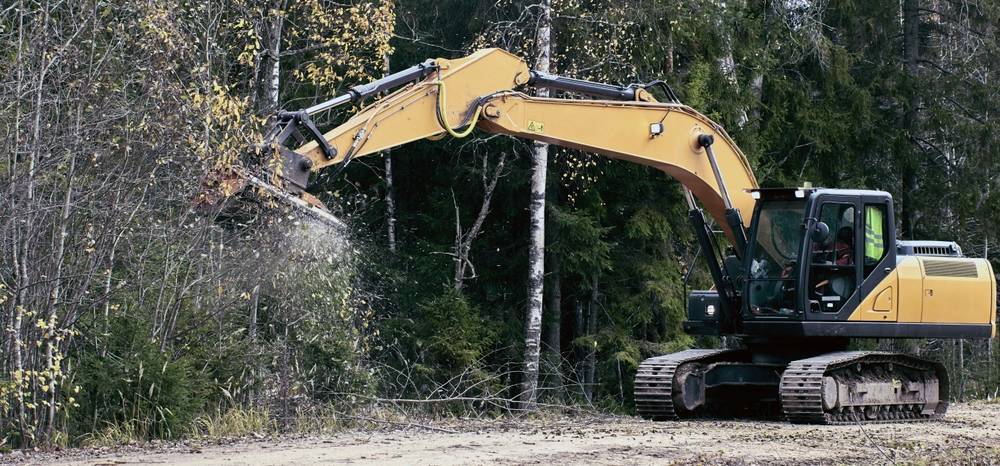
Disaster cleanup requires equipment that can take abuse, stay stable on irregular ground and work without interruption. Selection is not just about power. It is about design, balance and resistance.
Matching tool to terrain and risk
Mulchers that work well on farmland may fail in steep or saturated environments.
In disaster zones, carriers need low centers of gravity and heads that resist clogging. Tracked excavators or spider machines fitted with balanced mulching heads are often the safest choice in unstable ground.
You do not clear for aesthetics, you clear for survival. – Site manager after storm recovery in Louisiana
Key safety and performance features
Several features become critical in high-pressure situations. Anti-jamming systems protect time and hydraulics. Self-cleaning teeth reduce manual intervention. Housing must resist shocks, heat or mud, while maintaining visibility and control.
Here are some of the most effective features to look for when operating in unpredictable or high-risk terrain:
- Reinforced rotor structures
- Pressure relief valves
- Self-cleaning configurations
- Compact profiles
- Protected hydraulic flows
You can explore our machines page for setups built for emergency use.
Combining mulchers and chippers in the field
Responding to disaster damage requires flexibility. No single tool can handle every type of debris or terrain.
Mulchers and chippers each bring specific advantages, and using them together on the same site creates a more efficient and secure operation.
In unstable environments where time is limited and access is difficult, the right combination of equipment shortens delays and reduces physical exposure for field teams.
Understanding how each tool works allows crews to stay focused on priority tasks without backtracking or doubling efforts.
When to use a chipper over a mulcher
Chippers excel in post-clearing phases where large trunks or solid branches remain. They are particularly effective when the goal is to reduce material for later use, transport or storage. After a storm or fire, sections of trees may still be intact but too bulky for a mulcher to process efficiently. In such cases, a chipper delivers clean and uniform wood chips, suitable for energy production or compact disposal. This is especially valuable when managing waste logistics near populated areas or storage facilities.
How the two tools complement each other
A forestry mulcher clears the path, breaking down dense undergrowth, roots and medium debris directly on the ground. It creates safe access for teams and exposes larger remnants that can then be chipped.
Once the terrain is open, a chipper follows and processes what the mulcher leaves behind. This method eliminates the need for manual chainsaw work and reduces the time operators spend in unsafe conditions. It also helps avoid equipment overload, since each machine handles the type of material it is best suited for. The result is a safer, cleaner and faster clearing operation.
Learn more in our article what is the difference between a mulcher and a chipper.
Clearing access and securing zones
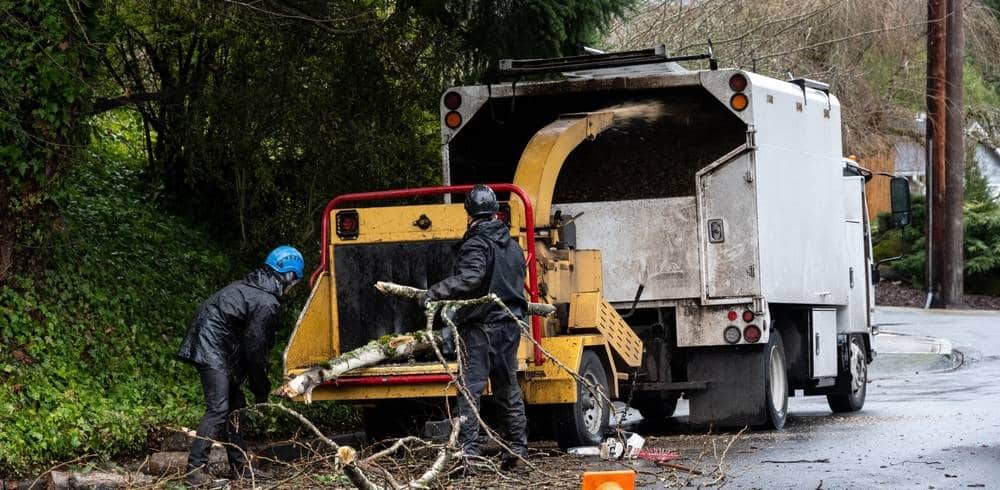
Opening roads and removing debris is only the first step in post-disaster land operations. Real recovery starts when critical zones are secured and access is restored not just for vehicles, but also for utilities, rescue teams and future reinforcements.
Using mulchers and chippers in coordination allows a quick transition from basic clearing to more strategic actions like protecting sensitive zones and stabilizing terrain.
Creating and widening emergency lanes
Time is a limiting factor when roads are blocked or reduced to narrow tracks. A forestry mulcher can clear passage fast, especially in tight or irregular spaces where other machines would struggle to turn, reverse or reposition.
Operators can expand lanes in hours, opening space for trucks, ambulances and fire crews without the delays linked to manual tools or repeated passes.
When paired with a chipper, the remaining trunks and branches are processed into clean output, leaving a clear and usable route for continuous operations.
Securing perimeters around sensitive areas
Hospitals, emergency shelters and power stations need protection after a natural disaster. Wind-damaged trees, dry vegetation and fallen limbs increase fire or collapse risks around these zones.
A mulcher is the most effective tool for creating firebreaks, buffer spaces and controlled clearings. It reduces biomass rapidly, with precision, even in close proximity to buildings or fencing.
Crews can secure perimeters without exposure to chainsaw risks or unstable terrain, and without compromising the integrity of the surrounding ground.
Visit our use cases section to see how these tools perform in the field.
Operator protection and machine resilience
In disaster environments, crews operate under pressure, with reduced visibility and little margin for error. Equipment must support and protect the operator at every stage. When ground conditions are unstable and access is unpredictable, the right design choices can mean the difference between safe progress and dangerous delays. A mulcher or a chipper must become an asset, not a liability.
Visibility and control in unstable zones
Collapsed structures, debris fields and flooded terrain often reduce the operator’s ability to judge depth, angle or direction.
Machines with oversized heads, obstructive frames or lagging control systems increase the risk of missteps. A mulcher or a chipper designed for disaster recovery offers low, compact profiles, wide visibility angles and responsive feedback.
Operators stay in control even when visibility is poor or space is limited. This is especially critical in areas with slope drop-offs, buried hazards or narrow access lanes.
Equipment that resists stress and overload
Disaster conditions are brutal and unpredictable. A single load may combine wet leaves, solid branches, half-burnt wood and embedded debris. Equipment not built for this level of variation will clog, overheat or seize. Purpose-built equipment must tolerate overloads without failing. This includes features like pressure regulation systems, reinforced bearings, smart hydraulic circuits and accessible maintenance points. By reducing the chances of breakdowns in critical phases, these tools support crews through long shifts and complex terrain.If you need help selecting the right configuration, request a quote and we will guide you through the options.
Working smarter to reduce secondary risks
Clearing everything is not always the right move. Disaster recovery often involves working with the land, not against it.
An effective disaster response is not just about speed, it is also about judgment. Clearing an area entirely may seem efficient, but in many cases it creates new problems. The terrain after a disaster is fragile. Using brute force can lead to further damage, soil instability or long-term degradation. The smartest interventions focus on what to clear, what to leave and how to adapt as conditions shift.
Avoiding over-clearing and erosion
Total vegetation removal may expose bare ground to heavy rains or wind, accelerating erosion and making the area harder to secure later. Slopes become vulnerable to landslides. Water channels may overflow without root structures to stabilize them.
A forestry mulcher allows controlled thinning instead of total clearing. Operators can remove surface biomass, invasive species or fire-prone brush while leaving root systems and essential cover intact. This approach supports both immediate access and long-term land resilience.
Adapting to live conditions on the ground
A disaster site is never static. The conditions can change every hour. Smoke from nearby fires, sudden rain or unstable structures may force teams to redirect quickly. Equipment must be ready to reposition, switch roles or adjust cutting intensity. Compact mulchers paired with mobile chippers offer this flexibility. A team can open a path, clear a buffer zone and redirect to a new task without needing entirely different machines. It is a field-tested combination that reduces downtime and helps crews work with the terrain instead of fighting it.You can contact us anytime for support or advice on high-pressure field operations.

